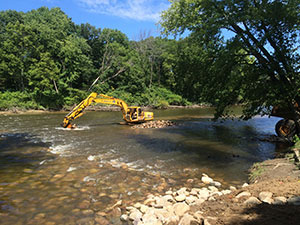(Provided by MDNR)
 Kalamazoo River Project Targets Spawning SturgeonRecently an excavator was moving rock out into the middle of the Kalamazoo River in southwest Michigan. An interested angler stopped to ask the crew what was going on.
Kalamazoo River Project Targets Spawning SturgeonRecently an excavator was moving rock out into the middle of the Kalamazoo River in southwest Michigan. An interested angler stopped to ask the crew what was going on.
"I told him we're building a spawning riffle for lake sturgeon," said Jay Wesley, Lake Michigan Basin Coordinator for the DNR. "That's a place where adult lake sturgeon can deposit their eggs. The eggs fall into the crevices of the rock and protect them against predators and turbulent flows."
The Kalamazoo River sturgeon riffle is approximately 26 miles upstream from Lake Michigan and 800 feet downstream of Allegan Dam. It is made of 4- to 24-inch field stone that is placed across the river. The overall size of the riffle is 22,400 square feet - about half the size of a football field.
The project was made possible by a $200,000 contribution from Consumers Energy and a $190,000 Great Lakes Tribal Coastal Grant provided to the Match-E-Be-Nash-She-Wish Band of Pottawatomi Indians (also known as the Gun Lake Tribe). The project features numerous partners; including the DNR's Parks and Recreation Division and Allegan Heavy Equipment Crew, Stantec (provided design) and Grand Valley State University (providing monitoring).
There are only about 20 to 30 adult lake sturgeon that make the marathon swim (26-miles) up from Lake Michigan in April to spawn. Adults may skip several years in between spawning. Currently, the spawning takes place immediately below the Consumers Energy Calkins Hydro-Facility, known locally as the Allegan Dam. The fish that make the trip seek out rocky habitat to deposit their eggs and most of the rock habitat previously available is immediately below the hydro-electric turbines. Unfortunately, the turbulent flow is too much for the eggs and many are washed downstream or become damaged in the high flows.
This project aims to entice the lake sturgeon to use the new riffle and all of its rocky characteristics - the ultimate goal is to keep the eggs healthy and prevent them from being damaged.
"There will be lots of little nooks and crannies for the eggs to fall into," explained Wesley. "When that happens predators - such as crayfish and round gobies - would have a hard time getting to them."
The riffle will also be useful for walleye, darters, smallmouth bass, suckers, steelhead, Chinook salmon and coho salmon which also like to spawn in that area.
The DNR has been working for nearly eight years to help the Kalamazoo River's population of lake sturgeon. This work includes understanding how many lake sturgeon are part of the overall population, which is estimated at about 180 adults. It also involves a partnership with the U.S. Fish and Wildlife Service, Gun Lake Tribe and Kalamazoo River Sturgeon for Tomorrow to operate a streamside rearing facility on the river.
"We really hope the lake sturgeon use this riffle to increase their natural reproduction and to assist our efforts to collect more fertilized eggs and larvae for the streamside rearing hatchery," said Wesley.
In the future a student will evaluate the use of the new riffle by fish in the river. If the project is successful, the DNR and partners will consider constructing similar riffles in other areas on the Kalamazoo River.


